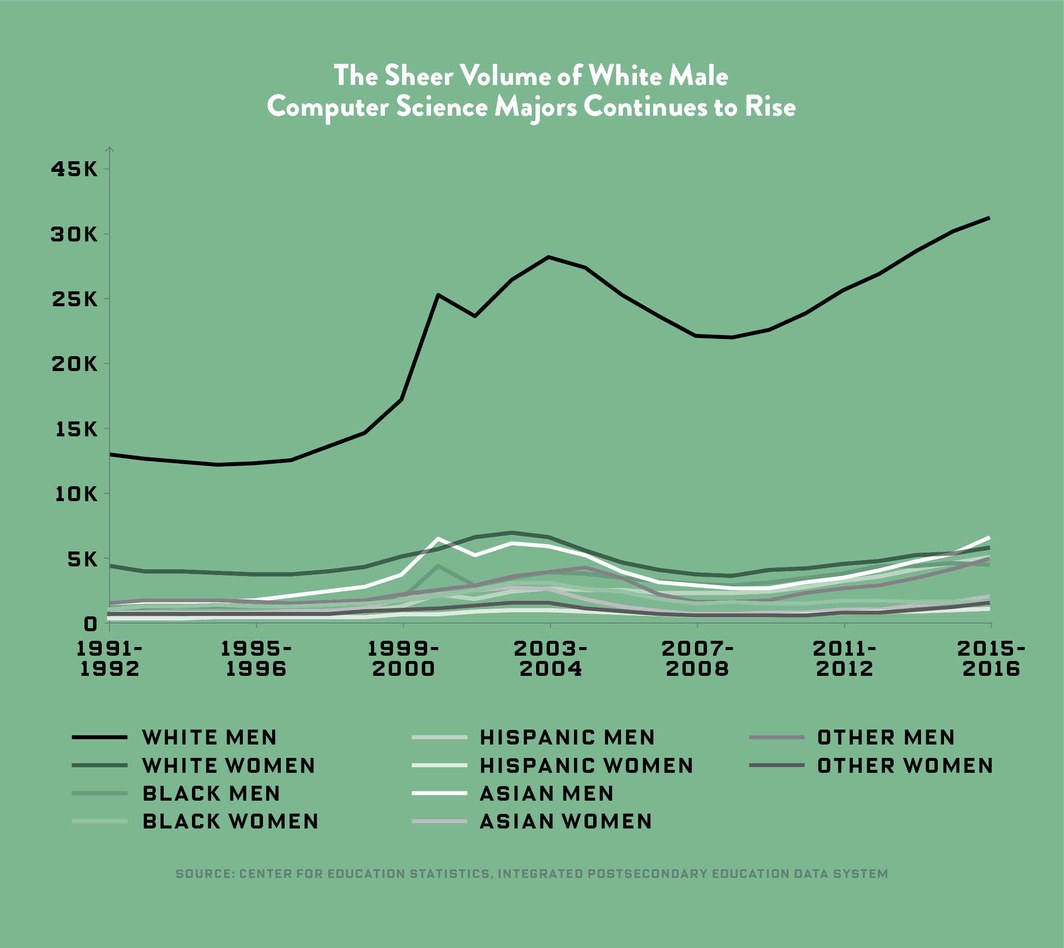Hiring for diversity
Approximately 3'30’’ minutes reading time
Ask yourself a question. “Do we hire for diversity”? If the answer is “We hire based on merit”, chances are you aren’t doing enough.
By leaving diversity to chance, you assume and expect a uniform distribution of people with different race, age, gender and social status to arrive at your doorstep.
This is not the case. Take tech as an example.
 Source: WOMEN AND MINORITIES IN TECH, Wired
Source: WOMEN AND MINORITIES IN TECH, Wired
As this chart shows, white men dominate college computer science departments. By a lot. One of the reasons for this may be the way companies try to recruit talent. Stanford researchers observed more than 75 recruiting sessions held by more than 60 companies and identified countless seemingly obvious ways the recruiters might be alienating female recruits, from sexist jokes to presentations displaying only slides of men.
I encourage you to read the whole article on Wired which is an excellent piece, on how the use of words, access to resources (e.g. computers at home) and salary inequality play a role.
Start by measuring the distribution among your current hires. One way to do this is by creating an anonymous, optional questionary. It’s important that you have a discussion first. Make sure everyone understands what the intent is and buys into it.
ustwo, a London agency, has gone a step further and created a public Diversity Dashboard to, as far as I can see, demonstrate commitment, raise awareness and to be held accountable.
Keep in mind that those numbers may also reveal a bias in hiring, while you believe you are merely focusing on merit.
A 2015 study followed up on this, and found that candidates with black-sounding names from elite universities did only as well as those with white-sounding names from less-selective schools.
Source: Is Blind Hiring the Best Hiring?, The New York Times
It may be possible that you are unknowingly exhibiting bias during your hiring process by expecting people to “fit in” rather than to “come as they are”. Feeding into a cultural conformity as opposed to diversity.
Who is present at an interview and how people express or respond can equally discourage people to come forward or be allowed to proceed. Having a diverse representation when you start from a non diverse background can be challenging.
Once again, ustwo has created a Head of Diversity role to tackle lack of equal representation head on and drive change.
We are completely overhauling our hiring process. This will include standardised questions and mixed interview groups. We will seek ways to ensure we are meeting a diverse range of candidates which we hope will lead to an increase in hiring of underrepresented candidates.
Whitney Berry, Head of Diversity, ustwo
Below I am only suggesting a list of actions that you could take, across different areas to help diversity flourish.
Education
- Work with local authorities to provide training to unemployed young people that have dropped out of education (NEET).
- Work with Universities to provide internships/placements to minority groups.
Hiring
- Take action to avoid discrimination based on gender/age/race when screening candidates.
- Involve a diverse group of people in the hiring process.
- Actively seek to hire minorities for head/management/leadership roles.
Support
- Support meetups and groups that give a voice to under represented people (e.g. LGBT) and invite them to talk in house to raise awareness.
- Fund people in need either directly or via a matching contribution to employees; KIVA.
- Fund charities and institutions that defend people’s rights to education and employment.
- Fund diversity tickets at conferences.
- Give people time off to volunteer in causes that have a social impact.
Day to day operations
- Be open, encourage and support ideas and views that challenge norms.
- Measure, track and have visibility on data that shows how diverse the company is.
- Provide parental leave as a work benefit.